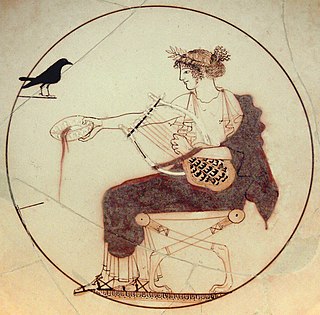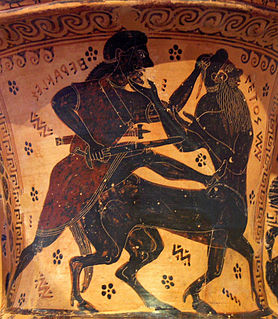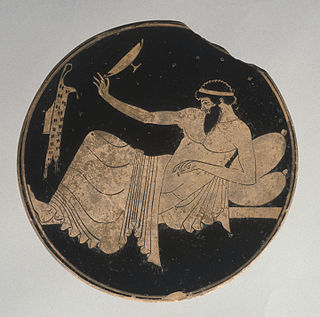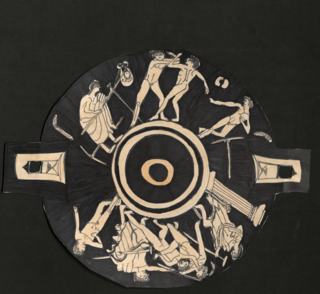Related Research Articles

In the pottery of ancient Greece, a kylix is the most common type of wine-drinking cup. It has a broad, relatively shallow, body raised on a stem from a foot and usually two horizontal handles disposed symmetrically. The main alternative wine-cup shape was the kantharos, with a narrower and deeper cup and high vertical handles.

Ancient Greek pottery, due to its relative durability, comprises a large part of the archaeological record of ancient Greece, and since there is so much of it, it has exerted a disproportionately large influence on our understanding of Greek society. The shards of pots discarded or buried in the 1st millennium BC are still the best guide available to understand the customary life and mind of the ancient Greeks. There were several vessels produced locally for everyday and kitchen use, yet finer pottery from regions such as Attica was imported by other civilizations throughout the Mediterranean, such as the Etruscans in Italy. There were a multitude of specific regional varieties, such as the South Italian ancient Greek pottery.

Exekias was an ancient Greek vase painter and potter who was active in Athens between roughly 545 BC and 530 BC. Exekias worked mainly in the black-figure technique, which involved the painting of scenes using a clay slip that fired to black, with details created through incision. Exekias is regarded by art historians as an artistic visionary whose masterful use of incision and psychologically sensitive compositions mark him as one of the greatest of all Attic vase painters. The Andokides painter and the Lysippides Painter are thought to have been students of Exekias.

Red-figure vase painting is one of the most important styles of figural Greek vase painting.
Oltos was a Late Archaic Greek vase painter, active in Athens from 525 BC to 500 BC. About 150 works by him are known. Two pieces, a cup in Berlin and a cup in Tarquinia, are signed by him as painter.

Douris or Duris was an ancient Athenian red-figure vase-painter and potter active c. 500 to 460 BCE.

Epiktetos was an Attic vase painter in the early red-figure style. Besides Oltos, he was the most important painter of the Pioneer Group. He was active between 520 BC and 490 BC. His name translates as "newly acquired", which is most probably a reference to his slave status.

White-ground technique is a style of white ancient Greek pottery and the painting in which figures appear on a white background. It developed in the region of Attica, dated to about 500 BC. It was especially associated with vases made for ritual and funerary use, if only because the painted surface was more fragile than in the other main techniques of black-figure and red-figure vase painting. Nevertheless, a wide range of subjects are depicted.

The Brygos Painter was an ancient Greek Attic red-figure vase painter of the Late Archaic period. Together with Onesimos, Douris and Makron, he is among the most important cup painters of his time. He was active in the first third of the 5th century BCE, especially in the 480s and 470s BCE. He was a prolific artist to whom over two hundred vases have been attributed, but he is perhaps best known for the Brygos Cup, a red-figure kylix in the Louvre which depicts the "iliupersis" or sack of Troy.

The Nessos Painter, also known as Netos or Nettos Painter, was a pioneer of Attic black-figure vase painting. He is considered to be the first Athenian to adopt the Corinthian style who went on to develop his own style and introduced innovations. The Nessos Painter is often known to be one of the original painters of black-figure. He only worked in this style, which is shown on his name vase in the National Archaeological Museum in Athens. Most of the known Nessos Painter ceramics were found in funerary settings such as cemeteries and mortuaries.

The Amasis Painter was an ancient Greek vase painter who worked in the black-figure technique. He owes his name to the signature of the potter Amasis, who signed twelve works painted by the same hand. At the time of the exhibition, "The Amasis Painter and His World" (1985), 132 vases had been attributed to this artist.

The Antiphon Painter was an Athenian vase painter of the early 5th century BC. He owes his name to a double Kalos inscription of Antiphon on the dinos stand in the Antique collection of Berlin. He was active between 500 and 475 BC in Athens as a painter of the red-figure style in the largest workshop of the 5th century. He learned his handicraft in the workshop of Euphronios and Onesimos. There he worked closely with them, the Kalmarer Painter and other painters.

Andokides was an ancient Athenian vase painter, active from approximately 530 to 515 B.C. His work is unsigned and his true name unknown. He was identified as a unique artistic personality through stylistic traits found in common among several paintings. This corpus was then attributed by John D. Beazley to the Andokides Painter, a name derived from the potter Andokides, whose signature appears on several of the vases bearing the painter's work. He is often credited with being the originator of the red-figure vase painting technique. To be sure, he is certainly one of the earliest painters to work in the style. In total, fourteen amphorae and two cups are attributed to his hand. Six of the amphorae are "bilingual", meaning they display both red-figure and black-figure scenes.

The pottery of ancient Greece has a long history and the form of Greek vase shapes has had a continuous evolution from Minoan pottery down to the Hellenistic period. As Gisela Richter puts it, the forms of these vases find their "happiest expression" in the 5th and 6th centuries BC, yet it has been possible to date vases thanks to the variation in a form’s shape over time, a fact particularly useful when dating unpainted or plain black-gloss ware.

The Tarquinia Painter was an ancient Attic vase painter working in red-figure technique during the early mid-5th century BCE. His artistic personality has been extrapolated by John Beazley from his type-piece, Tarquinia RC 1121, Museo Nazionale Tarquiniese, illustrated in Corpus Vasorum Antiquorum II, plate 22.1.

A mastos is an ancient Greek drinking vessel shaped like a woman's breast. The type is also called a parabolic cup, and has parallel examples made of glass or silver. Examples are primarily in black-figure or white ground technique, though early examples may be red-figure. A mastos typically has two handles and a "nipple" at the bottom, though some examples have a foot as a base instead. A mastoid cup is conical, but with a flat bottom, with or without handles.

The Bryn Mawr Painter is the name given to an Attic Greek red-figure vase painter active in the late Archaic period.

The few pottery exhibits of the Delphi Archaeological Museum include a famous shallow bowl (kylix) with an unusual depiction of the god Apollo. In the white-ground red-figure technique, it was found in a grave underneath the museum.

The bilingual eye-cup by the Andokides painter in the Museo Archeologico Regionale, Palermo, is a prime example of the transition from black-figure vase painting to the red-figure style in the late 6th century to early 5th century that commonly resulted in "bilingual" vases, using both styles. The Andokides painter created the red-figure style of pottery as we know it today during his working years from 530–515 BC. Starting around 530 BC the Andokides painter produced red-figure amphorae and a bilingual kylix. Fewer than 20 vases survive by the Andokides painter but they span 30-40 years of his career, allowing historians to trace the development of his painting styles. One of the earliest mentions of the Andokides painter was on a black-figure hydria by Timagoras around 550 BC, when the Andokides painter must have been an apprentice.

The kylix depicting athletic combats is a ceramic drinking cup made approximately in the late Archaic period, 490 B.C., in Attica. It is currently in the Museum of Fine Arts Boston as part of The Ancient World Collections. The artist, Onesimos, used red-figure technique for the decoration, which was invented in Athens around 530 B.C. and quickly became one of the leading modes of decoration Athenian potters used. Red-figure technique was favored because it allowed for a greater representation of garments, emotions and anatomy making it useful for artists, such as Onesimos, to use in painting athletic events.
References
- ↑ Avramidou, Amalia (2011). The Codrus Painter: Iconography and Reception of Athenian Vases in the Age of Pericles. Madison: Wisconsin University Press. p. 5.
- ↑ Avramidou, Amalia (2011). The Codrus Painter: Iconography and Reception of Athenian Vases in the Age of Pericles. Madison: Wisconsin University Press. p. 3.
- ↑ "A Red-figure kylix by the Codrus Painter". The British Museum, London.
- ↑ Avramidou, Amalia (2011). The Codrus Painter: Iconography and Reception of Athenian Vases in the Age of Pericles. Madison: Wisconsin University Press. pp. 5–6.